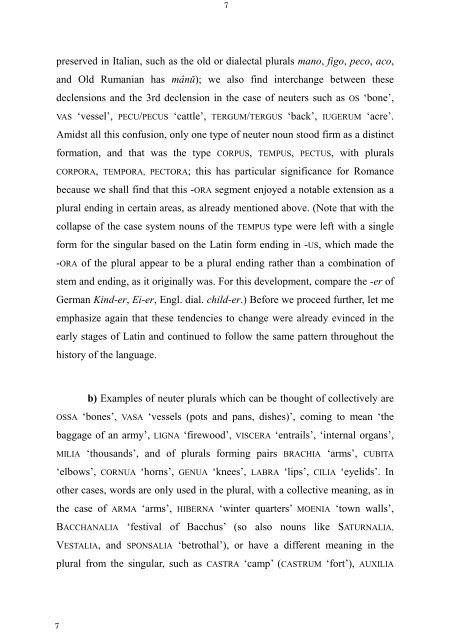The Latin Neuter Plurals in Romance - Page ON
The Latin Neuter Plurals in Romance - Page ON
The Latin Neuter Plurals in Romance - Page ON
You also want an ePaper? Increase the reach of your titles
YUMPU automatically turns print PDFs into web optimized ePapers that Google loves.
7<br />
7<br />
preserved <strong>in</strong> Italian, such as the old or dialectal plurals mano, figo, peco, aco,<br />
and Old Rumanian has mânŭ); we also f<strong>in</strong>d <strong>in</strong>terchange between these<br />
declensions and the 3rd declension <strong>in</strong> the case of neuters such as OS ‘bone’,<br />
VAS ‘vessel’, PECU/PECUS ‘cattle’, TERGUM/TERGUS ‘back’, IUGERUM ‘acre’.<br />
Amidst all this confusion, only one type of neuter noun stood firm as a dist<strong>in</strong>ct<br />
formation, and that was the type CORPUS, TEMPUS, PECTUS, with plurals<br />
CORPORA, TEMPORA, PECTORA; this has particular significance for <strong>Romance</strong><br />
because we shall f<strong>in</strong>d that this -ORA segment enjoyed a notable extension as a<br />
plural end<strong>in</strong>g <strong>in</strong> certa<strong>in</strong> areas, as already mentioned above. (Note that with the<br />
collapse of the case system nouns of the TEMPUS type were left with a s<strong>in</strong>gle<br />
form for the s<strong>in</strong>gular based on the <strong>Lat<strong>in</strong></strong> form end<strong>in</strong>g <strong>in</strong> -US, which made the<br />
-ORA of the plural appear to be a plural end<strong>in</strong>g rather than a comb<strong>in</strong>ation of<br />
stem and end<strong>in</strong>g, as it orig<strong>in</strong>ally was. For this development, compare the -er of<br />
German K<strong>in</strong>d-er, Ei-er, Engl. dial. child-er.) Before we proceed further, let me<br />
emphasize aga<strong>in</strong> that these tendencies to change were already ev<strong>in</strong>ced <strong>in</strong> the<br />
early stages of <strong>Lat<strong>in</strong></strong> and cont<strong>in</strong>ued to follow the same pattern throughout the<br />
history of the language.<br />
b) Examples of neuter plurals which can be thought of collectively are<br />
OSSA ‘bones’, VASA ‘vessels (pots and pans, dishes)’, com<strong>in</strong>g to mean ‘the<br />
baggage of an army’, LIGNA ‘firewood’, VISCERA ‘entrails’, ‘<strong>in</strong>ternal organs’,<br />
MILIA ‘thousands’, and of plurals form<strong>in</strong>g pairs BRACHIA ‘arms’, CUBITA<br />
‘elbows’, CORNUA ‘horns’, GENUA ‘knees’, LABRA ‘lips’, CILIA ‘eyelids’. In<br />
other cases, words are only used <strong>in</strong> the plural, with a collective mean<strong>in</strong>g, as <strong>in</strong><br />
the case of ARMA ‘arms’, HIBERNA ‘w<strong>in</strong>ter quarters’ MOENIA ‘town walls’,<br />
BACCHANALIA ‘festival of Bacchus’ (so also nouns like SATURNALIA,<br />
VESTALIA, and SP<strong>ON</strong>SALIA ‘betrothal’), or have a different mean<strong>in</strong>g <strong>in</strong> the<br />
plural from the s<strong>in</strong>gular, such as CASTRA ‘camp’ (CASTRUM ‘fort’), AUXILIA









